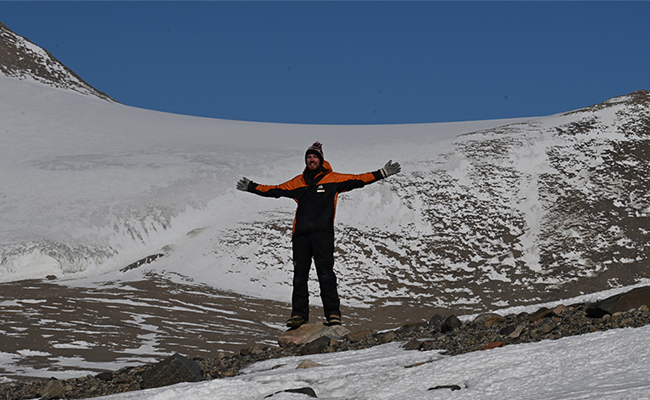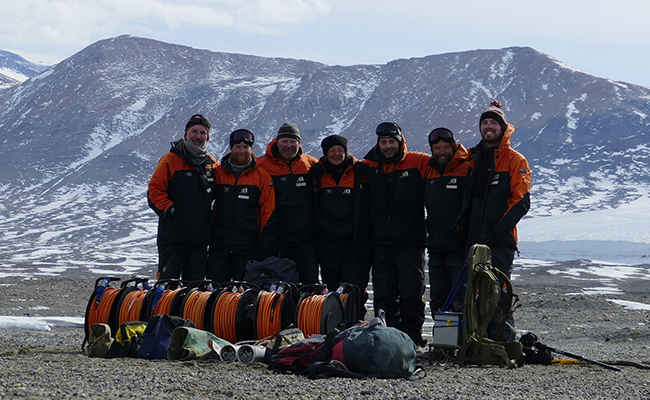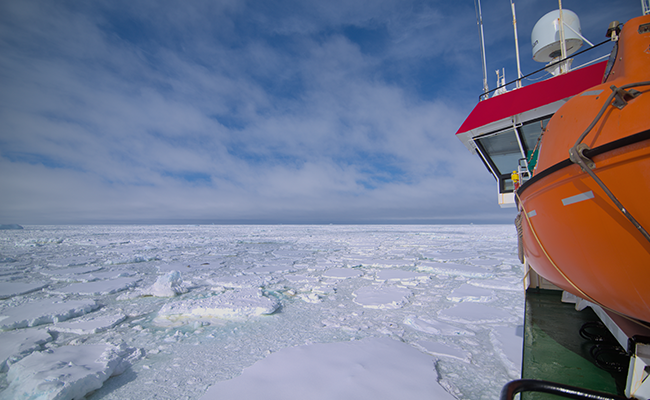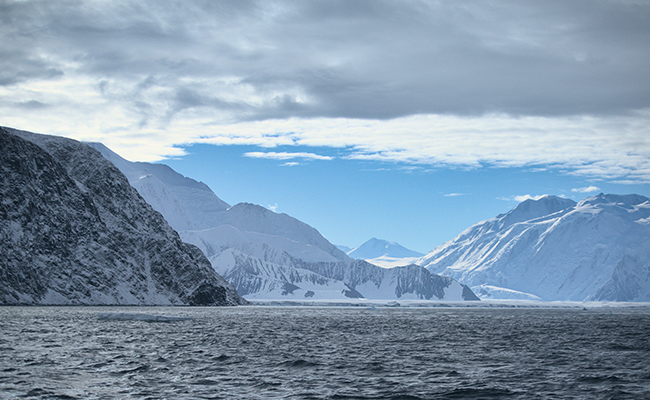Monday 25 July 2022 2:27pm

Jack Beagley taking in the view of Taylor Valley on a rare day off.
Sitting aboard an icebreaker ship and eating Italian pizza while watching seals and large chunks of ice float by is a surreal experience Jack Beagley will not forget in a hurry.
Beagley recently handed in his Master of Science thesis which looked at natural carbon sequestration in Fiordland.
His first trip to Antarctica, in 2021, was not directly related to his master’s research, but was for the same reason: a strong interest in understanding climate, past, present and future.
He applied to be a BLAKE Antarctic Ambassador through the educational and environmentally focused organisation named after Sir Peter Blake, and earned himself a spot on-board an Air Force Hercules aircraft, Antarctica bound, in November.
“The plane was very loud and quite cramped, but that was part of the experience – I wouldn’t change it one bit. It was good fun.”
He flew with 17 other people on what was mostly a cargo flight, and for the first five or so hours there was nothing to see but the open ocean.
“And then we saw sea ice, which was our first clue we were getting close.”
Another hour went by before the sea ice was replaced with ice covered mountains “as far as the eye can see”.
“It was insane, that was my first moment where I was really awestruck, which became a common theme during the trip.”
Aotearoa New Zealand’s base in Antarctica, Scott Base, is situated at 77 degrees south. After eight hours in the air the plane touched down.
“There were people waiting for us, basically a small settlement built at the airfield, handling all the cargo coming in and out.”
Jack spent a few nights in the Scott Base accommodation, which he says was a lot like a hostel, but one that had solid wood shutters instead of curtains to block out 100 per cent of the light.

A team photo in front of the Commonwealth Glacier after completing their survey in the Taylor Valley.
He was impressed by the logistics crew and the professionalism of “every single staff member”.
“I'm vegetarian, but there were no compromises made whatsoever. Despite being just 1350 kilometres from the South Pole the food was top notch.”
The field support team helped Beagley and the six people he was travelling with – four Kiwis and two Italians - head to their campsite in the Dry Valleys where they would spend three weeks in tents.
“The Dry Valleys are one of the really small parts of Antarctica that aren’t actually covered in ice. It was kind of loose soil and rocks and boulders, quite similar to the Tongariro Crossing.”
The team was gathering information for a multi-year-long project looking at how much greenhouse gas is being emitted from the ground in Antarctica. They used a type of imaging technique that measured the electrical resistance of the ground and enabled them to identify underground features– such as channels of very salty water, or faults – that might be related to the greenhouse gas emissions.
The survey required them to walk in a straight line and disregard topography.
“It’s not like ‘oh, we can go around that hill’, no, we actually had to go over the top and get the measurement there.”
At times he found himself scrabbling up slopes of loose rubble while carrying his 30kg backpack; “it was hard work”.
Living in permanent daylight was “pretty weird” but not as disconcerting as he anticipated.
The team was working hard to keep to a schedule which meant they were too tired come bedtime to be bothered by the light. It also was not as cold as he thought it would be, saying temperatures were between 0 and -15 degrees Celsius.
“It was very isolated and undisturbed. Despite fantastic communications and support from Scott Base there was a strong sense that very few humans were nearby or had ever even been there. It was a privilege and absolutely surreal.”

Breaking ice north of the Ross Sea.
Beagley returned to the frozen continent in February this year, this time as a part of an Italian expedition that set sail from Lyttleton.
Due to COVID-19, Italy’s National Antarctic Research Program was restricted in who it could send down to the ice. It needed someone who had a geophysics background, held the appropriate certifications for travelling to Antarctica and was already in New Zealand as border restrictions were still in place.
A ‘good word’ from Beagley’s supervisor helped seal the deal, and he was off.
“The second trip was different in every way. We took a boat down, and we didn’t get off the boat the whole time. Loose soil and rocks were replaced by ice floes and seals.”
The icebreaker took five days to get to George V Coast, 3500 kilometres directly south of Adelaide, Australia.
The main purpose of the expedition was to gain a better understanding of the behaviour of the glaciers making up the East Antarctic Ice Sheet.
This time, the scientific team was using an acoustic technique to identify seafloor features that indicate the past stability of these vast glaciers.
“The bottom of some of these glaciers is beneath sea-level, so if seawater gets underneath them it can lead to a nasty feedback loop and cause them to rapidly melt – directly raising sea levels.’
The constant sound of ice being crunched beneath the boat made it difficult to sleep, but the ice did offer some surreal sights.
“I was munching on some freshly made Italian pizza, and I looked out the window, and there were just chunks of ice in the water.
“We were cruising along and seeing seals on floes of ice right next to us, quite upset that there was some big red thing steaming through their home.”
Beagley was one of about 50 people aboard the boat for its five-week-long journey.

Taking in the Ironside Glacier after leaving Edisto Inlet.
While he was grateful of the opportunity to take in the amazing sights and experiences Antarctica had to offer, they weren’t his highlight.
“Antarctica is an amazing place, but my biggest takeaway from both expeditions was just how lucky we are to have such passionate scientists working on these really important climate problems.”
Beagley will start on his PhD later this year studying circulation in New Zealand’s fiords and its relation to carbon storage, but would like to eventually bring about change through getting a job in the Office of the Prime Minister’s Chief Science Advisor.
“I’m aware that although science is an important part of the climate crisis that we’re dealing with, it ultimately needs to effect change by influencing policy and engaging people.”
Kōrero by Koren Allpress, Internal Communications Adviser
